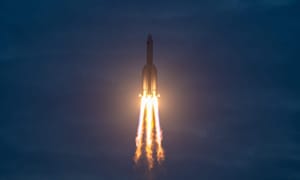
Jan 10, 2024
Chang'e 6 moves closer to launch
Recently the China National Space Administration announced that the Chang'e 6 lunar spacecraft had arrived at the Wenchang Space Launch Site on Wednesday, the 10th of January. Parts of the spacecraft arrived in two military aircraft at Haikou, the capital of the Hainan province, before being transported to Wenchang.
The spacecraft will be assembled and tested at Wenchang in preparation for launch in May. The launch vehicle is highly likely to be a Long March 5, the rocket likely has a large amount of hardware already at Wenchang ahead of the mission.
Chang'e 6 is a lunar sample return mission from the far side of the Moon, the first to do so, that will bring up to 2,000 grams of lunar samples back to Earth for study. The spacecraft was initially built as a backup for Chang'e 5 which successfully completed its mission back in late 2020.
The Chang'e 6 spacecraft in its launch configuration is believed to weigh 8,200 kilograms and consists of a service module, lander, ascent unit, and return vehicle.

The Chang'e 6 mission plan is believed to be as follows:
The spacecraft will be launched from the Wenchang Space Launch Site atop of a Long March 5 rocket and be placed onto a trans-lunar trajectory leaving the spacecraft bound for the Moon.
After separation from the Long March 5, once headed toward the Moon, the service module will bring the spacecraft into its desired orbit of the Moon. Once in orbit of the Moon, the lander will separate from the service module, with the ascent unit on top, and land on the surface.
On the surface, the lander and ascent unit will perform various experiments and gather the required samples. After the samples are secured in the ascent unit, the ascent unit will liftoff and rendezvous with the service module, which will still house the return vehicle. The two spacecraft will then dock and transfer the samples into the return vehicle.
After the samples are transferred into the return vehicle and secured the ascent unit will separate leaving the service module and return vehicle. Once at a safe distance from the ascent unit, the service module will light its engine to send the spacecraft on a return trajectory to Earth. At a predetermined point prior to entry into Earth's atmosphere, the spacecraft will angle itself for entry and separate the return vehicle from the service module.
Once through the heat of entry into Earth's atmosphere at speeds of over 11,000 meters a second, or roughly 24,500 miles per hour, the return vehicle will deploy its parachute and touchdown on land inside the People's Republic of China.
In support of Chang'e 6 the Queqiao-2 relay satellite is set to launch in March atop of a Long March 8 from the Wenchang Space Launch Site. The relay satellite is believed to have a 4.2-meter antenna and last eight years in orbit of the Moon.

Queqiao-2 will utilize an elliptical 'frozen orbit' of 300 by 8600 kilometers around the Moon to allow consistent communications with Chang'e 6. Future missions, Chang'e 7 and 8, are also expected to communicate through the relay satellite.
What is the Long March 5?
The Long March 5 is a two-stage launch vehicle that burns liquid hydrogen and liquid oxygen in its first and second stages as well as burning rocket-grade kerosene and liquid oxygen in its boosters. It is the largest and most capable rocket in operation for the People's Republic of China and has supported its lunar and crewed space science programs.
The Long March 5 rocket can place up to 25,000 kilograms into low Earth orbit, 14,000 kilograms into geosynchronous transfer orbit, up to 9,400 kilograms on a trans-lunar injection, 5,100 kilograms directly into geostationary orbit, and up to 15,000 kilograms into sun-synchronous orbit.

The four boosters are powered by two YF-100 engines each generating 245 tons of thrust each burning rocket-grade kerosene and liquid oxygen for two minutes and fifty-three seconds. The four boosters have a combined thrust of 979 tons of thrust.
The first-stage is powered by two YF-77 engines generating 143 tons of thrust burning liquid hydrogen and liquid oxygen for eight minutes and twelve seconds.
The second-stage is powered by two YF-75D engines generating 18 tons of thrust burning liquid hydrogen and liquid oxygen for eleven minutes and forty seconds.
The Long March 5 is manufactured by the China Academy of Launch Vehicle Technology and weighs up to 854,500 kilograms fully fuelled. When on the pad the rocket can be over 60 meters tall.



